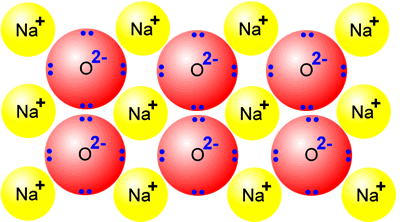Higher-level only
Entropy has been called 'nature's arrow', as all natural systems move towards a state of maximum disorder. This is one of the statements of the second law of thermodynamics. The reasons for this lie in the statistics of natural systems, but for simplicity we can consider entropy to be the degree of disorder within a substance.
Entropy is a state function, i.e. it depends only on the state of the substance and not how that state was reached.
Syllabus ref: R1.4.1Reactivity 1.4.1 - Entropy, S, is a measure of the dispersal or distribution of matter and/or energy in a system. (HL)
- The more ways the energy can be distributed, the higher the entropy. Under the same conditions, the entropy of a gas is greater than that of a liquid, which in turn is greater than that of a solid.
- Predict whether a physical or chemical change will result in an increase or decrease in entropy of a system
- Calculate standard entropy changes, ΔS⦵, from standard entropy values, S⦵.
Guidance
- Standard entropy values are given in the data booklet.
Tools and links
- Structure 1.1 - Why is the entropy of a perfect crystal at 0 K predicted to be zero?
Disorder
 Disorder
is the natural state of things, just think about your bedroom! Without careful
attention a bedroom soon becomes cluttered with things all over the place.
Disorder
is the natural state of things, just think about your bedroom! Without careful
attention a bedroom soon becomes cluttered with things all over the place.
The reason for this is fairly logical; there is only one situation in which everything is ordered in a bedroom, all of the socks in the correct drawer, the bed made, the books on the shelves, tee-shirts folded etc etc. However, there are millions of ways in which the room can be untidy.
 If
nature is left to itself, the most likely situation is one of disorder - the
probability of disorder is much greater.
If
nature is left to itself, the most likely situation is one of disorder - the
probability of disorder is much greater.
Natural systems do not usually have someone to arrange them, they adopt the most likely arrangement.
Within a natural system there are billions upon billions of particles, each of which can be given a wide range of energies. The system adopts one of the most likely states, i.e. a disordered state.
Entropy
Entropy is the term given to the natural disorder of the universe. If left to itself, the universe tends towards disorder. It can be thought of as an inevitable driving force. Entropy has been called 'nature's arrow'. It is the natural tendency of systems to become disordered.
 If
we look at a solid, we can see that all of the particles are carefully arranged
in specific locations. This is a highly organised and ordered system. Its
entropy is said to be very low.
If
we look at a solid, we can see that all of the particles are carefully arranged
in specific locations. This is a highly organised and ordered system. Its
entropy is said to be very low.
However, in a gas the particles are free to move randomly and with a range of speeds. The entropy of gases is high.
A liquid has more entropy than a crystalline solid, but much less than a gas.
A solution contains a mixture of solute and solvent particles and has more entropy than a simple liquid but, once again, far less than a gas.
Factors affecting entropy
Disorder can be increased by increasing the number of particles that have freedom of movement.
Gas particles have three degrees of freedom:
- 1 Translation
- 2 Rotation
- 3 Vibration
Translation refers to motion in a direction. Rotation is motion about an axis, and vibration means movement of the atoms with respect to one another within particles (stretching and bending of bonds).
Gases then, have a large amount of entropy.
The total entropy depends on the number of possible energy levels that the individual particles can have. This is a function of the temperature.
As the temperature increases the number of energy states available to the particles also increases. The number of possible arrangements of energy over all of the particles increases. This gives the system a greater choice of arrangements, i.e. more entropy.
Hence, entropy is a function of the number of particles and the total energy available to those particles.
The symbol for entropy in chemistry is capital S.
- Increase number of particles = increased entropy
- Increase temperature = increased entropy
Absolute Entropy
Entropy is defined as the degree of disorder inherent in a system. Unlike the chemical potential energy of a substance, entropy can be measured from an absolute baseline.
 When
a system has no disorder, i.e. it is perfectly arranged, and it has no energy,
(absolute zero kelvin) it can have no entropy.
When
a system has no disorder, i.e. it is perfectly arranged, and it has no energy,
(absolute zero kelvin) it can have no entropy.
These conditions are met in a perfect crystallline substance at absolute zero.
This allows us to measure, or calculate, absolute entropy values, i.e. the entropy when compared to this absolute zero entropy baseline.
There are various calculations that make this possible, based on thermodynamic data as well as statistics.
Explanations of these go beyond the scope of this book.
Tables of absolute entropy values are available and may be used to calculate entropy changes from one situation to another. Absolute entropy is measured in J K-1.
Note You should be aware of two important facts:
- 1 Gases have much more entropy than solids or liquids.
- 2 Entropy increases as the mass and complexity of a molecule increases.
Entropy change
The difference in entropy in any process, chemical or physical, is the entropy of the final situation minus the entropy of the initial situation. For a chemical reaction this is the difference between the products entropy and the reactants entropy, called the entropy change. IThe entropy change is symbolised by ΔS, delta S. When the entropy increases, ΔS is positive.
ΔS = S(final) - S(initial)
When the entropy is determined under standard conditions it is called the
standard entropy, ΔSo.
|
Example: Does the entropy of the system increase or decrease when a kettle boils? Before boiling the water is a liquid and has low entropy. After boiling the water becomes a gas and has much higher entropy. Therefore the entropy has increased and ΔS is positive. |
|
Example: Does the entropy of the following reaction increase or decrease ? N2(g) + 3H2(g) → 2NH3(g) On the left hand side of the equation there are four moles of gas and on the right hand side of the equation there are two moles of gas. The total amount of gas particles is decreasing and therefore the entropy is decreasing, ΔS is negative. |
One point to note is that the effect of energy input (temperature increase) on entropy is not the same at all temperatures, but rather depends on the absolute temperature. There is a greater increase in entropy at lower temperatures for a given energy input.
Hence, the entropy change is dependent on the temperature at which the change takes place. This can be expressed by the equation:
ΔS = q/T
where q is the energy input.
Worked examples
Q461-01 Which of the changes below occurs with the greatest increase in entropy?- Na2O(s) + H2O(l) → 2Na+(aq) + 2OH-(aq)
- NH3(g) + HCl(g) → NH4Cl(s)
- H2(g) + I2(g) → 2HI(g)
- C(s) + CO2(g) → 2CO(g)
|
Entropy can be considered the degree of disorder of a chemical system. It is increased by the number of particles and their temperature. In this case it is important to examine the number of moles of free particles on both sides of the equation. It may be seen that in equation D there are more moles of gas (maximum entropy) on the right hand side than on the left hand side. Thus the entropy increases from left to right. correct response Although there are more free ions in A this is not as important in entropy terms as an increase in the number of moles of gas. In equation B there is a large decrease in entropy (two gases make a solid) and in equation C the number of moles of gas on both sides is equal. |
Q461-02 In which of the following reactions is the entropy change ( S) closest to zero
- SO2(g) + ½O2(g) → SO3(g)
- Br2(l) → Br2(g)
- H2(g) + I2(g) → 2HI(g)
- 3Ca(s) + N2 → Ca3N2(s)
|
Entropy can be considered the degree of disorder of a chemical system. It is increased by the number of particles and their temperature. In this case it is important to examine the number of moles of free particles, i.e. gas, on both sides of the equation. Equation A the moles of gas decreases from reactants to products, ΔS is negative. Equation B the moles of gas increases from 0 to 1, ΔS is positive. Equation C the moles of gas stays the same from reactants to products, ΔS = 0. correct response Equation D the moles of gas decreases from 1 to 0, ΔS is negative. |
Q461-03 Estimate, without doing a calculation, the magnitude of the entropy change for the following reaction.
Fe2O3(s) + 2Al(s) → 2Fe(s) + Al2O3(s)
Answer|
Examination of the equation reveals that the compounds on both sides of the equation are in the solid state. As solids have very low entropy it is safe to estimate that the entropy difference between reactants and products is negligible. Hence ΔS = 0. |
Q461-04 Consider the following reaction:
N2(g) + 3H2(g) → 2NH3(g)
The absolute entropy values, S, at 300K for N2(g), H2(g)
and NH3(g) are 193, 131 and 192 JK-1 mol-1
respectively. Calculate ΔSo
for the reaction and explain the sign of So.
|
On the left hand side there is one mole of nitrogen and three moles of hydrogen. Their entropy = 193 + (3 x 131) = 586 JK-1 On the right hand side there are two moles of ammonia. Entropy = (2 x 192) = 384 JK-1 The entropy change, ΔS The negative sign indicates that the entropy has decreased from reactants to products. |
Q461-05 Which reaction has the greatest positive entropy change?
- CH4(g) + 1½O2(g) → CO(g) + 2H2O(g)
- CH4(g) + 1½O2(g) → CO(g) + 2H2O(l)
- CH4(g) + 2O2(g) → CO2(g) + 2H2O(g)
- CH4(g) + 2O2(g) → CO2(g) + 2H2O(l)
|
A positive entropy change means that the products have more entropy than the reactants. Gases have the largest entropy values, therefore we are looking for the reaction that produces the greatest positive change in moles of gas. reaction 1 2½ moles gas → 3 moles of gas. An increase by ½ mole gas correct response reaction 2 2½ moles gas → 1 mole of gas. A decrease of 1½ mole gas reaction 3 3 moles gas → 3 moles of gas. No change in moles reaction 4 3 moles gas → 1 mole of gas. A decrease of 2 moles of gas |
Q461-06 Which reaction occurs with the largest increase in entropy?
- Pb(NO3)2(s) + 2KI(s) → PbI2(s) + 2KNO3(s)
- CaCO3(s) → CaO(s) + CO2(g)
- 3H2(g) + N2(g) → 2NH3(g)
- H2(g) + I2(g) → 2HI(g)
|
An increase in entropy change means that the products have more entropy than the reactants. Gases have the largest entropy values, therefore we are looking for the reaction that produces the greatest positive change in moles of gas. reaction 1 0 moles gas → 0 moles of gas. No change in moles of gas reaction 2 0 moles gas → 1 mole of gas. A increase of 1 mole of gas correct response reaction 3 4 moles gas → 2 moles of gas. A decrease of 2 moles of gas reaction 4 2 moles gas → 2 mole of gas. No change in moles of gas |
Q461-07 Some chlorine gas is placed in a flask of fixed volume at room temperature. What change will cause a decrease in entropy?
- Adding a small amount of hydrogen
- Adding a small amount of chlorine
- Cooling the flask
- Exposing the flask to sunlight
|
Anything that increases the disorder, such as mixing two gases, or increasing the temperature, increases the entropy. The reverse is also tru. Hence decreasing the temperature decreases the entropy, e.g. Cooling the flask |
Q461-08 Which reaction has the largest positive value of ΔS
- CO2(g) + 3H2(g) → CH3OH(g) + H2O(g)
- 2Al(s) + 3S(s) → Al2S3(s)
- CH4(g) + H2O(g) → 3H2(g) + CO(g)
- 2S(s) + 3O2(g) → 2SO3(g)
|
An increase in entropy change means that the products have more entropy than the reactants. Gases have the largest entropy values, therefore we are looking for the reaction that produces the greatest positive change in moles of gas. reaction 1 4 moles gas →
2 moles of gas. A decrease of 2 moles of gas, ΔS reaction 2 0 moles gas →
0 mole of gas. No change in moles of gas, ΔS reaction 3 2 moles gas →
4 moles of gas. An increase of 2 moles of gas, ΔS reaction 4 3 moles gas →
2 mole of gas. A decrease of 1 mole of gas, ΔS |
Q461-09 Which equation represents a change with a negative value for ΔS?
- 2H2(g) + O2(g) → 2H2O(g)
- H2O(s) → H2O(g)
- H2(g) + Cl2(g) → 2HCl(g)
- 2NH3(g) → N2(g) + 3H2(g)
|
A negative value for ΔS means that the products have less entropy than the reactants. There are fewer moles of gas in the products than in the reactants. reaction 1 3 moles gas → 2 moles of gas. A decrease of 1 moles of gas, ΔS = negative correct response reaction 2 0 moles gas → 1 mole of gas. An increase by 1 mole of gas, ΔS = positive reaction 3 2 moles gas → 2 moles of gas. No change in moles of gas , ΔS = 0 (approx) reaction 4 2 moles gas → 4 mole of gas. An increase by 2 moles of gas, ΔS = positive |
Q461-10 Which change does not lead to an increase in entropy?
- Mixing nitrogen and oxygen gases at room temperature
- Cooling steam so that it condenses to water
- Heating hexane to its boiling point
- Dissolving sugar in water
|
Entropy is increased by:
From the choices given, only cooling steam reduces the entropy of the system |
